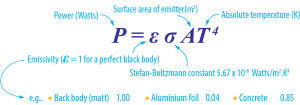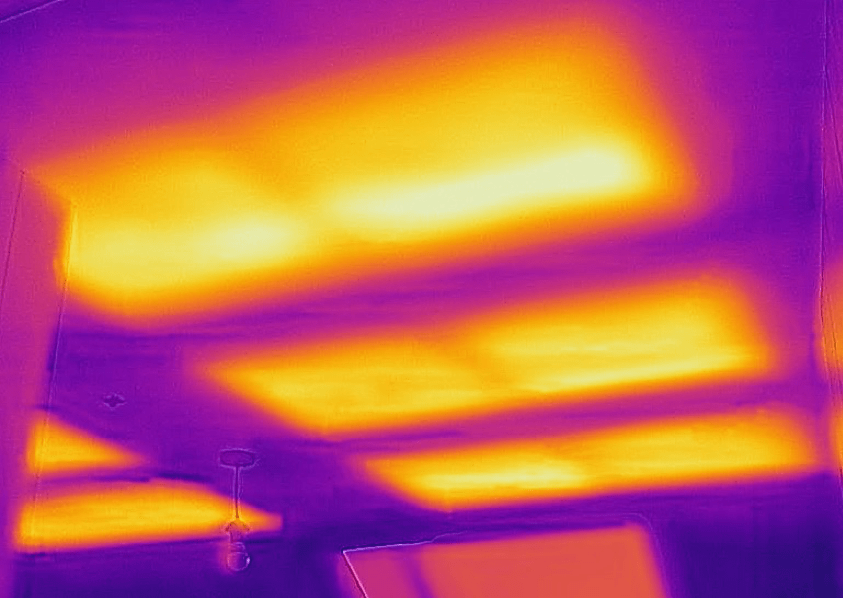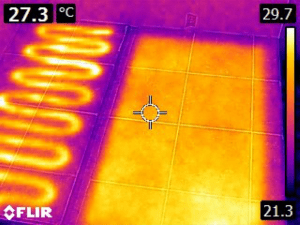The Answer?
Radiant Comfort Heat!
The goal of any residential heating solution is to create a warm and comfortable environment for it’s residents. Ceiling heating is no exception to this rule! However, ceiling heating is unique in that it heats primarily through radiative heating. Radiative heating solutions emit safe radiant heat from their surfaces which then in turn heat up the surrounding surfaces creating a warm and comfortable environment faster and more efficiently than convective heating solutions such as floor heating or A/C.
However, not all radiant heat is created equal. To ensure maximization of the radiant heating effect in a given space, we need to understand the three most important variables when it comes to generating radiant heat as per Stefen-Boltzmann’s law

Stefen-Boltzmann’s Law
These Being the Following:
- Surface Material
- Surface Area
- Surface Temperature
Surface Material:
A materials ability to emit energy via radiation is dependent on it’s emissivity, emissivity is a value (0-1) which describes a materials ability to absorb and emit radiation. A value closer to 1 indicates a higher capability of emitting/absorbing radiation and a value closer to 0 indicates a lower capability.
Luckily, the vast majority of ceiling materials such as indoor paints, plaster, and wall paper all have emissivities ranging from .82-.92.

Aluminium foil has one of the worst emissivities with .03emissivity。

Human Skin has one of the highest known emissivities of .98.
Surface Area:
Simply put, the greater the surface area the more heat can be released via radiation. So through the use of say a full surface heating element which creates a homogenous surface temperature, heating via radiation can be maximized versus non full surface heating solutions.
Surface Temperature:
The surface temperature also plays a very crucial role in determining the overall effectiveness of a radiative heating solution. In general the higher the temperature the more energy is emitted via radiation. This would tend to explain why current on the market radiant heaters all reach 85-100C surface temperature if panels or well above 200C if rod radiators for industrial applications.
Why Then Only 55C Surface Temperature?
With any residential or commercial heating system the goal is to create a warm environment while also maintaining the comfort of the people within.
Based on studies done by ASHRAE once the surface temperature of a radiant heat source begins to exceed 60C the %PPD (percent perceived dissatisfied) I.E the amount of people that begin to find the sensation/experience uncomfortable begins to increase rapidly. On a practical level this can be thought of as feeling as an uncomfortable amount of heat coming from the ceiling. So in order to create a comfortable indoor environment for as many people as possible a radiant surface temperature of 55C finds the right balance between effectiveness and comfort.
Besides comfort, another benefit is that at 55C the heating surfaces have no negative impact on the surrounding building materials, minimizing any risk of plaster cracking or surface discoloration of occurring, and can be touched without any safety concerns.
If the goal is to achieve the most comfortable heating effect as efficiently as possible, then using radiant heating systems with a surface temperature of 55C is a must!



I need to to thank you for this good read!! I certainly loved every bit of it. I have you bookmarked to check out new stuff you postÖ
Thanks, Glad it helped you!
The 55 Degrees Ceiling Surface Temperature is an excellent choice for several reasons. Firstly, it provides optimal thermal comfort in living spaces, preventing discomfort caused by cold drafts or overheating. Secondly, this temperature helps reduce condensation and mold growth, ensuring a healthier indoor environment. Additionally, the 55-degree surface temperature promotes energy efficiency by minimizing heat loss through the ceiling. This not only saves on heating costs but also contributes to a greener footprint. Lastly, the balanced temperature enhances the aesthetics of the room by eliminating unsightly temperature gradients. Overall, the 55 Degrees Ceiling Surface Temperature is a well-thought-out solution that prioritizes comfort, health, energy efficiency, and aesthetics.